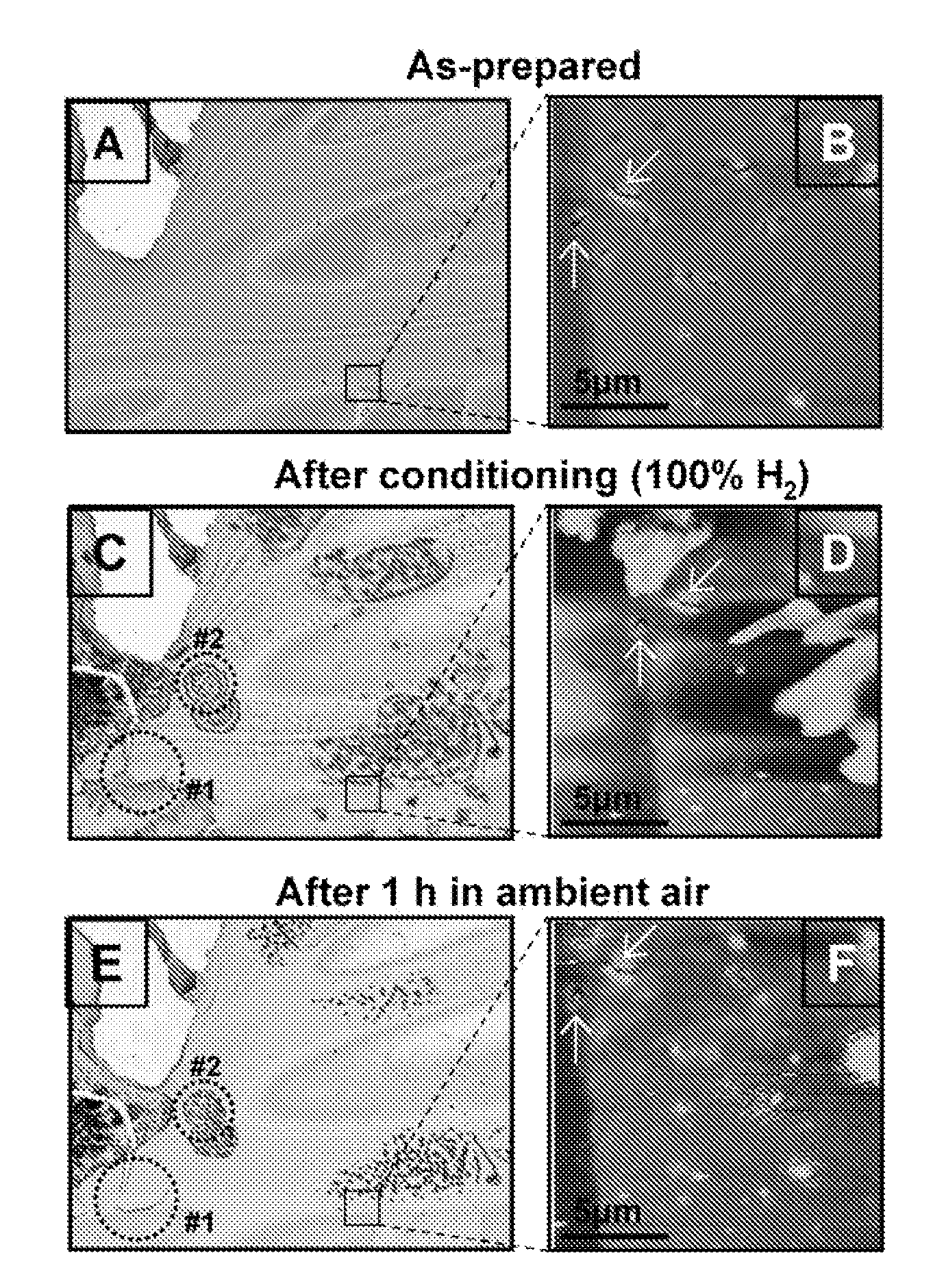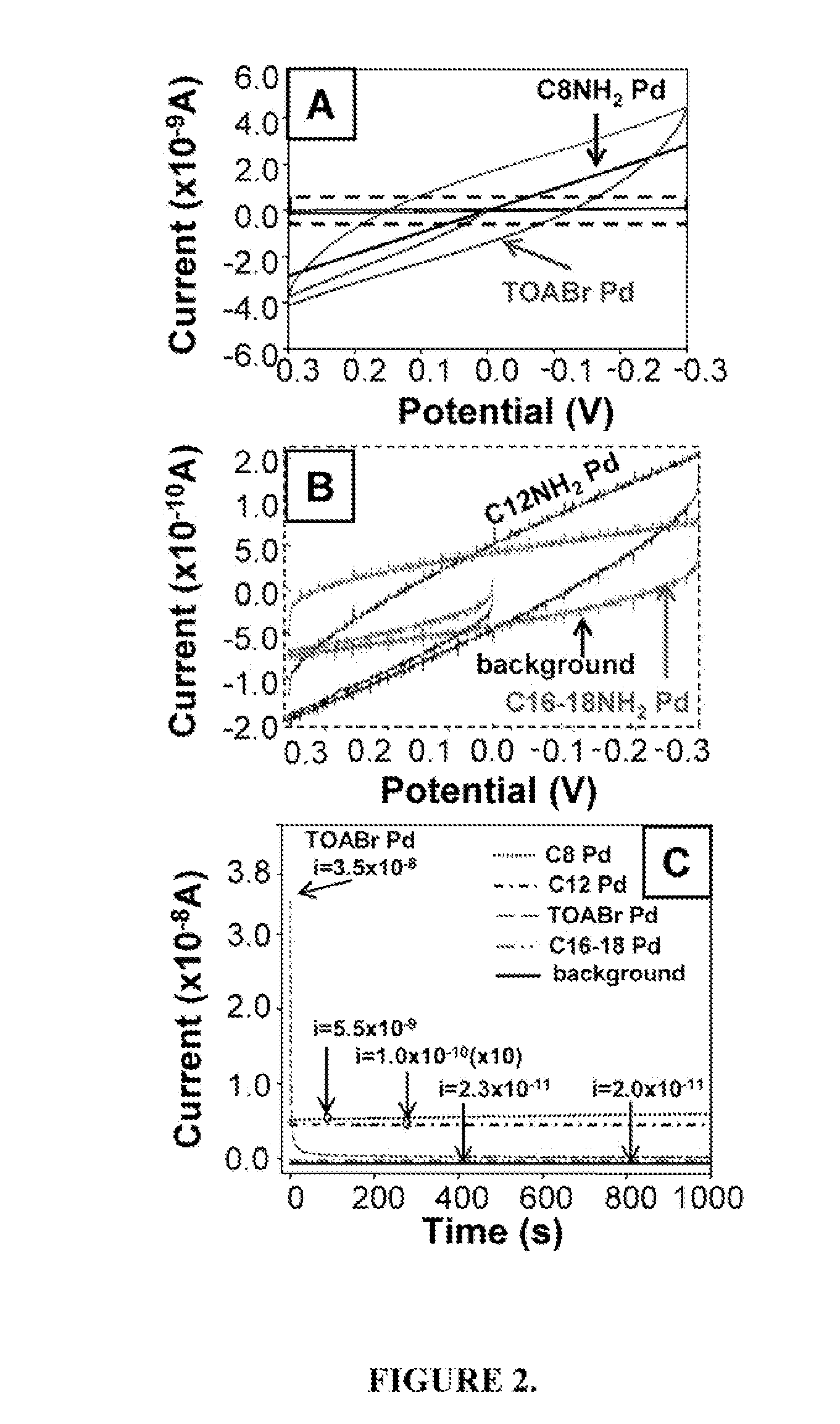Chemical sensors for detecting hydrogen and methods of use
- Summary
- Abstract
- Description
- Claims
- Application Information
AI Technical Summary
Benefits of technology
Problems solved by technology
Method used
Image
Examples
example 1
Sensor Device
[0067]FIG. 1 shows an exemplary device used to test the reactivity of hydrogen with various solid-state films of alkylamine- and tetraoctylammonium bromide-coated Pd, Pd / Ag, and Pd / Au nanoparticles by monitoring changes in conductivity in the presence of various hydrogen concentrations with N2 or air as the carrier gas. The exemplary device depicted in FIG. 1 consists of two Au electrodes with a chromium adhesion layer on a Si / SiOx substrate separated by 23 μm at the closest point, which was fabricated by standard photolithography, sputtering, and lift-off procedures. Frame A shows the device before and Frame B shows the device after drop-cast deposition of a film of C8H17NH2-coated Pd nanoparticles. The figure also illustrates the various metal compositions (Pd, Pd / Ag, and Pd / Au) and protecting ligands used, which includes hexanethiolate (C6H13S), octylamine (C8H17NH2), dodecylamine (C12H25NH2), hexadecylamine-octadecylamine (C16H36NH2 / C18H37NH2), and tetraoctylammoniu...
example 2
Electronic Properties of Alkylamine- and TOABr-Coated Pd Nanoparticles
[0068]FIG. 2A shows the current-voltage (I-V) curves for drop-cast deposited films of C8H17NH2, C12H25NH2, C16H36NH2 / C18H37NH2, and TOABr-coated Pd nanoparticles. FIG. 2B shows the films of C12H25NH2-coated Pd, C16H36NH2 / C18H37NH2-coated Pd nanoparticles, and background expanded (see dashed box in FIG. 2A). The current through the film of C8H17NH2-coated Pd nanoparticles is linear with potential, showing ohmic behavior. Current through the film of C12H25NH2-coated Pd nanoparticles is also ohmic, but shows hysteresis because the current is close to the level of the background. The I-V curve for the film of C16H36NH2 / C18H37NH2-coated Pd nanoparticles is very close to the background (with no coated-nanoparticles deposited), indicating little conductivity through this film. The shape of the curves and the fact that the conductivity, which is proportional to the slope of the I-V curve, decreases with increasing chain l...
example 3
Reactivity of Films of Alkylamine- and TOABr-Coated Pd Nanoparticles to 100% H2
[0073]FIG. 3 shows the current as a function of time flowing through films of C6H13S—, C8H17NH2—, C12H25NH2—, and TOABr-coated Pd nanoparticles at a voltage of −0.3 V where 100% H2 or 100% air (or N2 for C6H13S—,) is flowing over the sensor device at various times as indicated by H2 “on” (arrow down) and H2 “off” (arrow up), respectively. Films of C16H36NH2 / C18H37NH2-coated Pd nanoparticles had very little conductivity and did not change in the presence of 100% H2 for up to 2000 s and therefore are not shown in FIG. 3. The current is stable for C6H13S—, C8H17NH2—, C12H25NH2-coated Pd nanoparticles in 100% air initially as also shown in FIG. 2. In the presence of 100% H2, FIG. 3A shows that the current passing through a selected film of C6H3S-coated Pd nanoparticles changed irreversibly from about 5.0×10−8 to 7.0×10−8 A over a 1000 s period (see inset for expanded plot). This small, irreversible change in...
PUM
 Login to View More
Login to View More Abstract
Description
Claims
Application Information
 Login to View More
Login to View More - R&D
- Intellectual Property
- Life Sciences
- Materials
- Tech Scout
- Unparalleled Data Quality
- Higher Quality Content
- 60% Fewer Hallucinations
Browse by: Latest US Patents, China's latest patents, Technical Efficacy Thesaurus, Application Domain, Technology Topic, Popular Technical Reports.
© 2025 PatSnap. All rights reserved.Legal|Privacy policy|Modern Slavery Act Transparency Statement|Sitemap|About US| Contact US: help@patsnap.com



